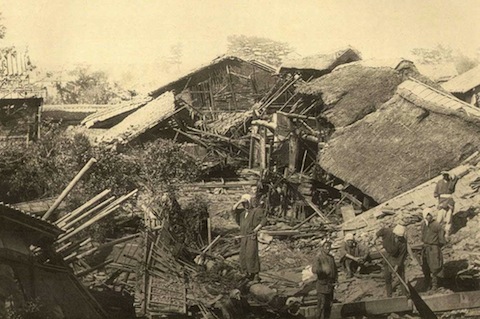
I was all set to end the week with a post about a particularly egregious patent-medicine fraud, but it somehow seems wrong in light of the catastrophe in Japan. We often forget how much our species is at the mercy of the planet, and how quickly everything we treasure can be snatched away. For the moment, I can only take small comfort in the fact that my Japanese friends appear to be present and accounted for.
The silver lining here, though, is that the death toll in Japan would have been much, much worse had the nation not committed long ago to sound engineering. As previously discussed on Microkhan, it is disturbingly easy to predict an earthquake’s death toll based on both the magnitude of the tremor and, more important, the quality of the building stock. Scarred by several 19th-century earthquakes that decimated its population, Japan started taking earthquake safety seriously once it attained the requisite level of prosperity to enforce building codes. There is no way to calculate how many thousands of lives were saved today by the bureaucracy ensures that constructions firms don’t cut corners, and that private builders are appropriately punished for using sub-standard materials or ill-conceived designs.
One point to reiterate from my earlier earthquake post: A Nobel Prize certainly awaits the man or woman who can come up with a low-cost building material capable of mimicking timber’s strength. Japan is prosperous enough to afford materials that can bend and sway when rocked by the Earth; less fortunate nations are stuck with concrete, which is the last thing you want your house to be made of when a mega-tremor strikes.
(Photo from The Great Earthquake of Japan, 1891, via Baxley Stamps)
Update One of today’s great hero’s passed away 41 years ago: Tachu Naito, the father of Japanese earthquake-proof architecture. Great summary of his contributions here:
The 1923 Kanto Earthquake caused the establishment of the first seismic regulations in a building code in the world to affect a concentration of large engineered structures—the 1924 Building Code Enforcement Regulations. Building code regulations had been passed after the 1908 earthquake in Italy and in earlier Italian earthquakes, but the 1924 legislation is historic for its application to Tokyo and other intensively developed urban areas that had large structures. The seismic ratio (“shindo”) method in that code, using a 10% force level, was based on the work of Toshikata Sano of the University of Tokyo and his student, Tachu Naito (1886-1970), who became the head of structural engineering at Waseda University. Prior to that 1924 mandatory code, Naito had incorporated such thinking and carried out the necessary seismic calculations and detailing in his design of several large structures that performed well in 1923, such as the Kabuki Theater and Industrial Bank of Japan.
This was a historic first in earthquake engineering: A structural engineer employed seismic analysis computations, carefully designed the structure to resist those seismic loads, detailed the construction to implement new construction practices, and then saw the resulting building tested by a major earthquake. Naito’s buildings performed very well in contrast to the standard non-seismic designs of an American firm doing work in Tokyo at the same time, the George Fuller Company. They also did well as compared to the significantly damaged Imperial Hotel of Frank Lloyd Wright (1867-1959). (Reitherman, 1980) Wright’s admittedly brilliant architectural skills, as well as his knack for self- promotion, gave him a reputation as a heroic seismic designer in the popular press, but the engineering world was impressed by Naito.
Per the faith-based encyclopedia, Naito’s “Eureka!” moment occurred after he observed shifting luggage in an accelerating train. Wish I could get more backstory on that revelation, but my Japanese skills are basically zilch.


Like gas stations in rural Texas after 10 pm, comments are closed.